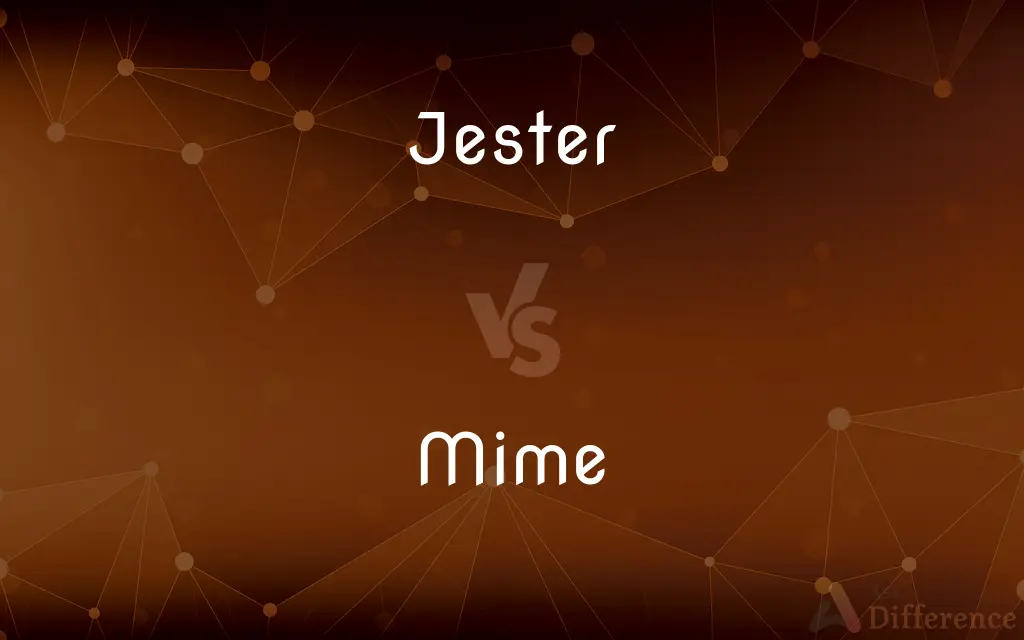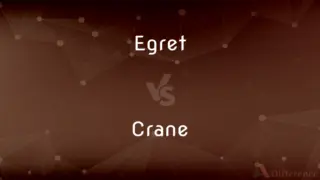Jester vs. Mime — What's the Difference?
By Fiza Rafique & Urooj Arif — Updated on March 10, 2024
Jesters were entertainers with verbal humor, while mimes use silent physical comedy to entertain.

Difference Between Jester and Mime
Table of Contents
ADVERTISEMENT
Key Differences
Jesters were historically entertainers in medieval courts, known for their witty and sometimes bawdy humor. They often used verbal jokes, storytelling, music, and physical comedy to entertain royal courts and their guests. On the other hand, mimes focus primarily on silent performance, using exaggerated gestures, facial expressions, and body movements to convey stories or emotions without the use of spoken words or sounds.
Jesters, in their role, were allowed to mock and joke about the nobility and even the monarchy in a way that others could not, serving as a form of social commentary and criticism. Whereas mimes, through their art, often explore universal themes of humanity, such as love, sorrow, and joy, relying on the audience's imagination and empathy to understand the narrative without any verbal explanation.
The attire of jesters was distinctively colorful and eccentric, often featuring a multicolored outfit with bells and a distinctive hat, known as a fool's cap. Mimes, contrastingly, traditionally wear black and white striped shirts with black pants, sometimes accompanied by white face makeup to accentuate facial expressions and convey emotion more effectively.
While jesters were specific to certain historical and cultural contexts, primarily in Europe during the medieval period, mime as a form of entertainment has a broader and more universal appeal, with roots in ancient Greece and Rome, and is practiced worldwide in various forms today.
Jesters often performed as part of a larger entertainment ensemble in royal courts, providing a mix of comedy, storytelling, and music. Mimes, however, usually perform solo or in small groups, focusing on visual storytelling through movement and expression without the aid of props, sets, or spoken dialogue.
ADVERTISEMENT
Comparison Chart
Medium of Entertainment
Verbal and physical comedy
Silent physical comedy
Historical Context
Medieval Europe
Ancient Greece and Rome to present
Typical Attire
Multicolored outfit with bells
Black and white clothing, often with face makeup
Performance Style
Interactive, with storytelling and music
Non-verbal, focusing on expression and movement
Themes
Social commentary and humor
Universal human experiences
Compare with Definitions
Jester
A performer who could freely mock social norms and authority under the guise of humor.
The jester uniquely had the king’s permission to mock the nobility without repercussion.
Mime
An artist who relies on exaggerated actions and emotions to communicate with the audience.
With every movement, the mime brought the characters of his story to life.
Jester
Someone who wears colorful and eccentric costumes as part of their act.
The jester’s attire, complete with bells and a fool's cap, was as entertaining as his jokes.
Mime
Someone traditionally dressed in black and white, using minimal props.
The mime, dressed in his stark black and white attire, captivated the crowd.
Jester
An entertainer who often incorporated music, storytelling, and acrobatics into their performances.
The jester captivated the audience with a mix of acrobatics, lute playing, and tales of far-off lands.
Mime
An entertainer whose art form has roots in ancient theatrical traditions.
Drawing from ancient traditions, the mime’s act connected the past with the present.
Jester
A jester, court jester, or fool, was historically an entertainer during the medieval and Renaissance eras who was a member of the household of a nobleman or a monarch employed to entertain guests. Jesters were also itinerant performers who entertained common folk at fairs and town markets.
Mime
A performer who uses silent expression through body movements and facial gestures to tell a story.
The mime conveyed a tale of love and loss without uttering a single word.
Jester
A professional entertainer with the duty to amuse their audience using jokes and humorous acts.
The king’s jester was adept at creating laughter with his clever wordplay.
Mime
A performer skilled in portraying complex narratives and emotions without speech.
The mime’s performance of struggle and triumph was deeply moving.
Jester
An historical figure in medieval courts known for their witty and satirical performances.
In the royal court, the jester’s satire often veiled critical commentary on politics.
Mime
A communications protocol that allows for the transmission of data in many forms, such as audio, binary, or video.
Jester
A professional joker or ‘fool’ at a medieval court, typically wearing a cap with bells on it and carrying a mock sceptre.
Mime
A form of ancient Greek and Roman theatrical entertainment in which familiar characters and situations were farcically portrayed on stage, often with coarse dialogue and ludicrous actions.
Jester
One given to jesting.
Mime
A performance of or dialogue for such an entertainment.
Jester
A fool or buffoon at medieval courts.
Mime
A performer in a mime.
Jester
One who jests, jokes or teases.
Mime
A modern performer who specializes in comic mimicry.
Jester
A person in colourful garb and fool's cap who amused a medieval and early modern royal or noble court.
Mime
The art of portraying characters and acting out situations or a narrative by gestures and body movement without the use of words; pantomime.
Jester
Any of various nymphalid butterflies of the Southeast Asian genus Symbrenthia.
Mime
A performance of pantomime.
Jester
A buffoon; a merry-andrew; a court fool.
This . . . was Yorick's skull, the king's jester.
Dressed in the motley garb that jesters wear.
Mime
An actor or actress skilled in pantomime.
Jester
A person addicted to jesting, or to indulgence in light and amusing talk.
He ambled up and downWith shallow jesters.
Mime
To ridicule by imitation; mimic.
Jester
A professional clown employed to entertain a king or nobleman in the middle ages
Mime
To act out with gestures and body movement.
Mime
To act as a mimic.
Mime
To portray characters and situations by gesture and body movement.
Mime
A form of acting without words; pantomime.
Mime
A pantomime actor.
Mime
A classical theatrical entertainment in the form of farce.
Mime
A performer of such a farce.
Mime
A person who mimics others in a comical manner.
Mime
Any of various papilionid butterflies of the genus Chilasa or Papilio, that mimic other species in appearance.
Mime
A unit of imitation in the theory of symbiosism.
Mime
To mimic.
Mime
(intransitive) To act without words.
Mime
To represent an action or object through gesture, without the use of sound.
In this game, you're given a word, which you have to mime to the others in the group.
Mime
A kind of drama in which real persons and events were generally represented in a ridiculous manner; an ancient Greek or Roman form of farce.
Mime
An actor in such representations.
Mime
The art of representing actions, events, situations, or stories solely by gestures and body movements, without speaking; pantomime{3}.
Mime
An actor who performs or specializes in mime{3}; an actor who communicates entirely by gesture and facial expression; a pantomime{2}; a pantomimist; a mimer.
Mime
A mimic.
Mime
To mimic.
Mime
An actor who communicates entirely by gesture and facial expression
Mime
A performance using gestures and body movements without words
Mime
Imitate (a person, a manner, etc.), especially for satirical effect;
The actor mimicked the President very accurately
Mime
Act out without words but with gestures and bodily movements only;
The acting students mimed eating an apple
Common Curiosities
Were jesters only found in Europe?
While most commonly associated with medieval Europe, similar figures existed in other cultures worldwide.
Did jesters wear specific costumes?
Yes, jesters wore distinctive, colorful costumes with bells and often a special hat called a fool's cap.
How do mimes communicate?
Mimes communicate through silent physical expression, using body movements and facial gestures.
Can mimes use props in their performances?
Yes, mimes can use props, but they typically rely on minimalistic approaches to enhance their silent storytelling.
What is the main difference between a jester and a mime?
The main difference lies in their mode of entertainment; jesters use verbal and physical comedy, while mimes focus on silent physical expression.
Was there a purpose to a jester’s satire?
Jesters used satire and humor as a form of social commentary, sometimes critiquing the monarchy and nobility.
What did jesters do?
Jesters entertained through jokes, stories, music, and acrobatics, often in medieval European courts.
Are mimes always silent?
Mimes are traditionally silent, focusing on conveying stories and emotions through movement and expression.
Are jesters still present today?
While traditional court jesters are not common, modern equivalents exist in entertainers who incorporate humor and satire.
Did jesters only perform for royalty?
Primarily, jesters performed for royalty and nobility, but they also entertained broader audiences at public events.
Do mimes wear makeup?
Yes, mimes often wear white face makeup to accentuate their facial expressions.
Is mime popular worldwide?
Yes, mime is practiced and appreciated in various cultures around the world, transcending language barriers.
What skills were important for a jester?
Jesters needed a wide range of skills, including humor, storytelling, music, and sometimes acrobatics.
Can mime be considered a form of art?
Yes, mime is considered a form of performing art that expresses complex narratives and emotions silently.
How do audiences understand mimes if they don't speak?
Audiences understand mimes through their exaggerated physical actions and expressions, which convey clear narratives or emotions.
Share Your Discovery

Previous Comparison
Egret vs. Crane
Next Comparison
Complacency vs. ApathyAuthor Spotlight
Written by
Fiza RafiqueFiza Rafique is a skilled content writer at AskDifference.com, where she meticulously refines and enhances written pieces. Drawing from her vast editorial expertise, Fiza ensures clarity, accuracy, and precision in every article. Passionate about language, she continually seeks to elevate the quality of content for readers worldwide.
Co-written by
Urooj ArifUrooj is a skilled content writer at Ask Difference, known for her exceptional ability to simplify complex topics into engaging and informative content. With a passion for research and a flair for clear, concise writing, she consistently delivers articles that resonate with our diverse audience.














































